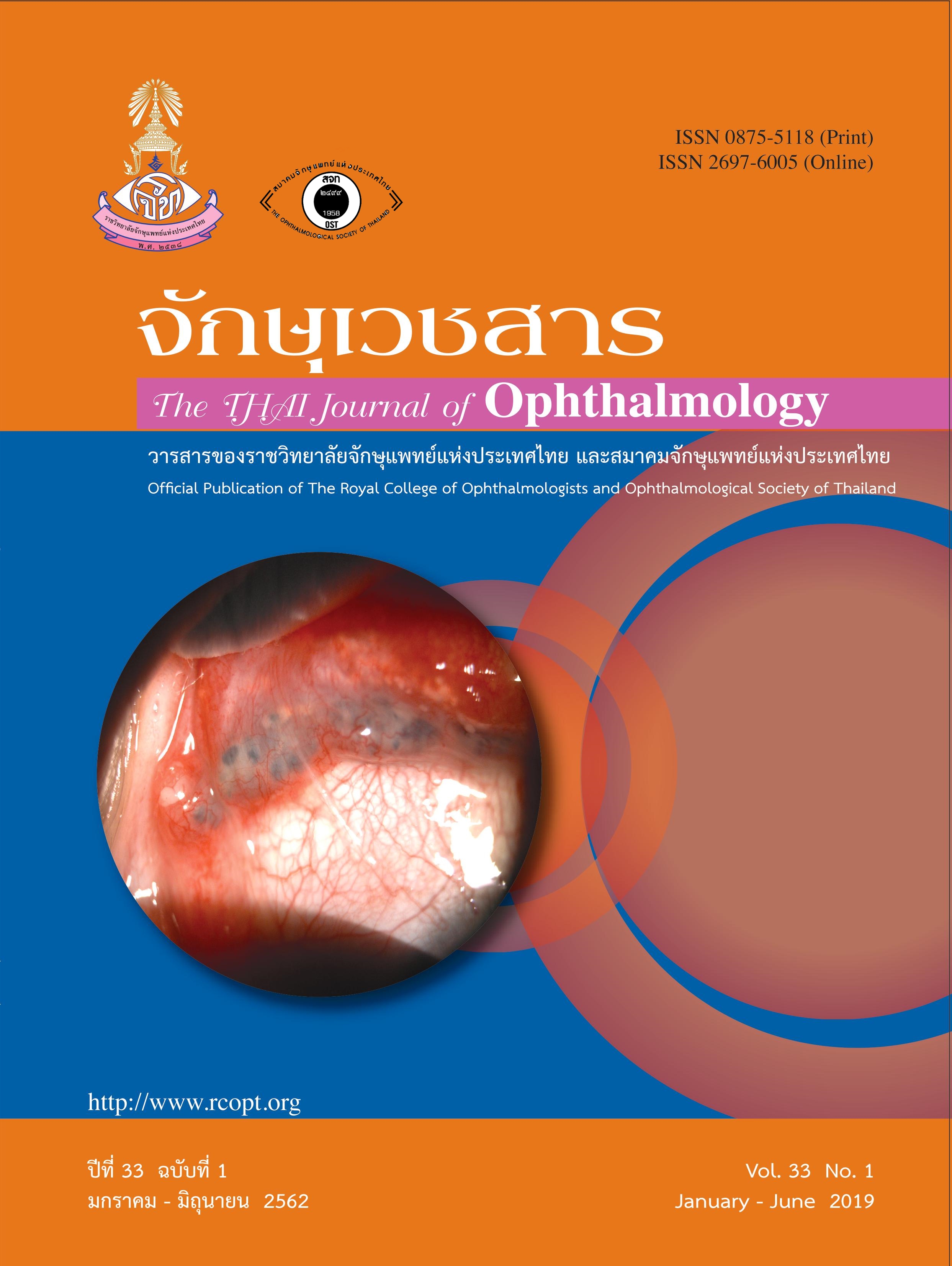Factors affecting Recurrence of Nasolacrymal Duct Obstruction after Endonasal Dacryocystorhinostomy
Abstract
Objective: To determine factors affecting failure in endoscopic endonasal dacryocystorhinostomy.
Study design : A retrospective cohort
Methods: The study was conducted by retrospective data collection in Nakornping hospital from July
2007 to June 2017. Patients who underwent endoscopic endonasal dacryocystorhinostomy and had been
followed for at least 6 months were included. An outcome was surgical failure defined as unchanged
epiphora and irrigated nasolacrymal duct cannot pass through throat.
Results: A total of 102 patients (137 eyes) were included. The mean age was 58.04 year (SD 15.66 years),
Majorily of patients were women (85.36%). Factors affected surgical failure are dacryocytitis (Adjusted RR
2.60 ; 95% CI 1.13-5.99, p=0.024), and difficult anatomy (Adjusted RR 2.17 ; 95% CI 1.21-3.87, p=0.009).
Conclusions: Surgeons and patients should make surgery plan together for endoscopic endonasal
dacryocystorhinostomy, especially those having dacryocystitis do need an early surgery.
References
Nerad JA. MD FACS. Tecniques in Opthalmic Plastic Surgery. SAUNDERS: ELSEVIER ; 2010.
Weidenbecher M, Hosemann W, Buhr W. Endoscopic endonasal dacryocystorhinostomy : result in 56 patients. Ann Otol Rhinol Laryngol. 1994;103:363-7.
Caldwell GW. Two new operations for obstruction of the nasal duct with preservation of canaliculi and incidental description of a new lachrymal probe. Am J Opthalmol. 1893;10: 189-193.
Dale HR. Endoscopic intranasal dacryocystorhinostomy : Result in four patients. ArchOtolaryngol Head Neck Surg.1990; 116 : 1061.
Mcdonogh M. Mering JH. Endoscopic transnasal dacryocystorhinostomy. J Laryngol. 1989; 103: 585-7.
Goldberg RA. Endonasal dacryocystorhinostomy: Is it really less successful? Arch Opthalmol.2004; 122:108-110.
Becker BB. Tricomponent Model of lacrymal pump mechanism. Opthamology. 1992;1139-1145.
Pathak VK, Das D, Bhuyan.UT, et al. A Study On Factors Affecting Outcome In Endoscopic Dacryocystorhinostomy. IOSR Journal of Dental and Medical Sciences ( IOSR-JDMS ).2013;5(5):1-3.
Penttila E, Smirnov G, Tuomilecgto H, et al.Endoscopic dacryocystorhinostomy as treatment for lower lacrimal pathway obstructions in adults . Allergy Rhinol. 2015; 12-19.
Leong SC ,Macewen CJ, and While PS. A systemic review of outcomes after dacryocystorhinostomy in adults. Am J Rhinol Allergy.2010; 24 : 81-90.
Koonrungsesomboon C. Result of Endoscopic Intranasal Dacryocystorhinostomy. Buddachinaraj medical journal. 2010; 27 : 15-24.
Jokinen K, Kaja J, Finland O. Endonasal Dacryocystorhinostomy. Arch Otolarygol. 1974;100:41-44.
Puapermpoonsiri P. Nasolacrimal duct obstruction and Treatment. Vajira medical journal. 2010;54: 367-372.
Limpisathain S, Kesornsukhon N. Endonasal Endoscopic Dacryocystorhinostomy (EESC-DCR) for treatment of Nasolacrimal Duct Obstruction in Samutsakorn Hospital.Reg 6-7 Med J. 2008;27:151-157.
Bartley GB. Acquired lacrimal drainage obstruction : An eitiologic classification system, case reports, and a review of the literature Part 3. Opthal Plast Recostr Surg.1993; 9:11-26.
Ozer O, Unlu GEH, Issag A, et al. Chronic inflammation : a poor prognosis Factor for endoscopic dacryocystorhinostomy. Europeon Archives of Rhino-laringology. 2012 ;269(3): 839-845.
Madge SN, MRCP FRCOphth, Chan WO,et al. Endoscopic Dacryocystorhinostomy in Acute Dacryocystitis : A multicenter case series. Orbit The International Journal on Orbital Disorders, oculoplastic and Lacrymal Surgery. 2011;30(1):1-6.
Rabina G, Golan S, Nendorfer M, et al. External Dacryocystorhinostomy : Characteristic and Surgical outcome in patient with and without previous Dacryocystitis. Journal of Opthalmology . 2013. Available from: https://www.ncbi.nlm.nih.gov/pmc/articles/PMC3880706/.
Davies MJ, Lee S, Lemtze S, et al. Predictors of Anatomical Patency Following Primary Endonasal Dacrycystorhinostomy : A Pilot Study. Orbit.2011;30(1): 49-53.
Hararuk K. The study of Nasolacimal Duct Obstruction Patients Treated at Takuapa Hospital, 4 years’ experience. Reg 10 Med J. 2017;31:317-323.
Mak ST, Fonglo IY, Wong ACM. Prognostic Factora For outcome of endoscopic Dacryocystorhinostomy in patient with Primary acquired nasolcrimal duct obstruction. Graefe’s Archive For Clinical and Experimental Opthalmology. 2013; 251(5):1361-1367.
Hammondi, Dena S, Tucker, Nancy A. Factors associated with outcome of Endonasal Dacryocystorhinostomy. Opthalmic plastic & Reconstructive Surgery . 2011;27(4):266-269.
Downloads
Published
Issue
Section
License
The Thai Journal of Ophthalmology (TJO) is a peer-reviewed, scientific journal published biannually for the Royal College of Ophthalmologists of Thailand. The objectives of the journal is to provide up to date scientific knowledge in the field of ophthalmology, provide ophthalmologists with continuing education, promote cooperation, and sharing of opinion among readers.
The copyright of the published article belongs to the Thai Journal of Ophthalmology. However the content, ideas and the opinions in the article are from the author(s). The editorial board does not have to agree with the authors’ ideas and opinions.
The authors or readers may contact the editorial board via email at admin@rcopt.org.


